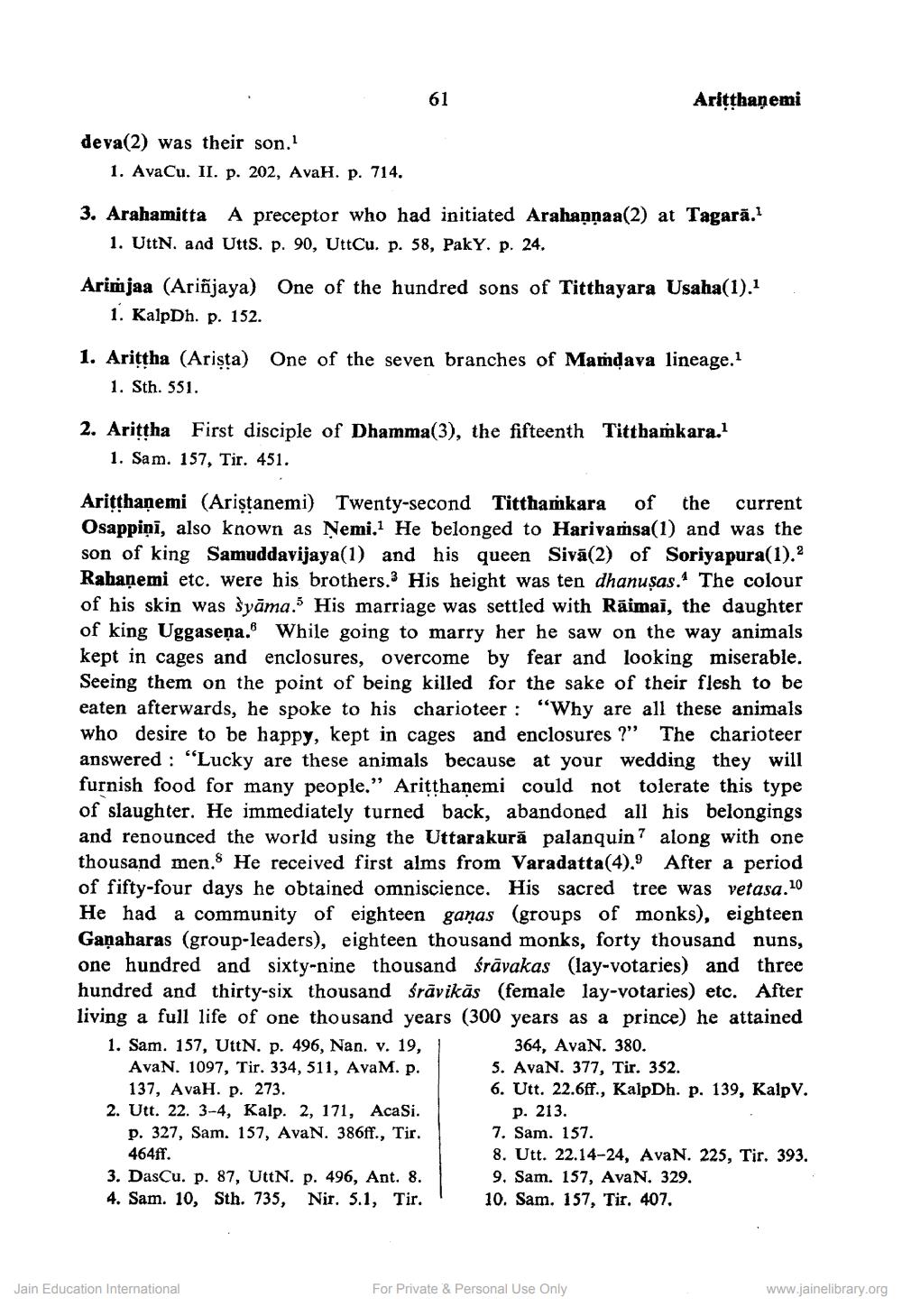________________
deva(2) was their son.1
1. AvaCu. II. p. 202, AvaH. p. 714.
3. Arahamitta A preceptor who had initiated Arahannaa(2) at Tagară.1 1. UttN. and UttS. p. 90, UttCu. p. 58, PakY. p. 24.
61
Arimjaa (Ariñjaya) One of the hundred sons of Titthayara Usaha(1).1 1. KalpDh. p. 152.
1. Arittha (Arista) One of the seven branches of Mamdava lineage.1
1. Sth. 551.
Aritthanemi
2. Arittha First disciple of Dhamma(3), the fifteenth Titthamkara.1 1. Sam. 157, Tir. 451.
1. Sam. 157, UttN. p. 496, Nan. v. 19, AvaN. 1097, Tir. 334, 511, AvaM. p. 137, AvaH. p. 273.
2. Utt. 22. 3-4, Kalp. 2, 171, AcaSi. p. 327, Sam. 157, AvaN. 386ff., Tir. 464ff.
Aritthanemi (Ariṣṭanemi) Twenty-second Titthamkara of the current Osappiņi, also known as Nemi.1 He belonged to Harivamsa(1) and was the son of king Samuddavijaya(1) and his queen Siva(2) of Soriyapura(1).2 Rahanemi etc. were his brothers. His height was ten dhanuṣas. The colour of his skin was syāma. His marriage was settled with Raimai, the daughter of king Uggasena. While going to marry her he saw on the way animals kept in cages and enclosures, overcome by fear and looking miserable. Seeing them on the point of being killed for the sake of their flesh to be eaten afterwards, he spoke to his charioteer: "Why are all these animals who desire to be happy, kept in cages and enclosures?" The charioteer answered: "Lucky are these animals because at your wedding they will furnish food for many people." Ariṭṭhanemi could not tolerate this type of slaughter. He immediately turned back, abandoned all his belongings and renounced the world using the Uttarakura palanquin along with one thousand men. He received first alms from Varadatta (4). After a period of fifty-four days he obtained omniscience. His sacred tree was vetasa.10 He had a community of eighteen ganas (groups of monks), eighteen Gaṇaharas (group-leaders), eighteen thousand monks, forty thousand nuns, one hundred and sixty-nine thousand śravakas (lay-votaries) and three hundred and thirty-six thousand śrāvikās (female lay-votaries) etc. After living a full life of one thousand years (300 years as a prince) he attained
3. DasCu. p. 87, UttN. p. 496, Ant. 8. 4. Sam. 10, Sth. 735, Nir. 5.1, Tir.
Jain Education International
364, AvaN. 380.
5. AvaN. 377, Tir. 352.
6. Utt. 22.6ff., KalpDh. p. 139, KalpV. p. 213.
7. Sam. 157.
8. Utt. 22.14-24, AvaN. 225, Tir. 393.
9. Sam. 157, AvaN. 329.
10. Sam. 157, Tir. 407.
For Private & Personal Use Only
www.jainelibrary.org




